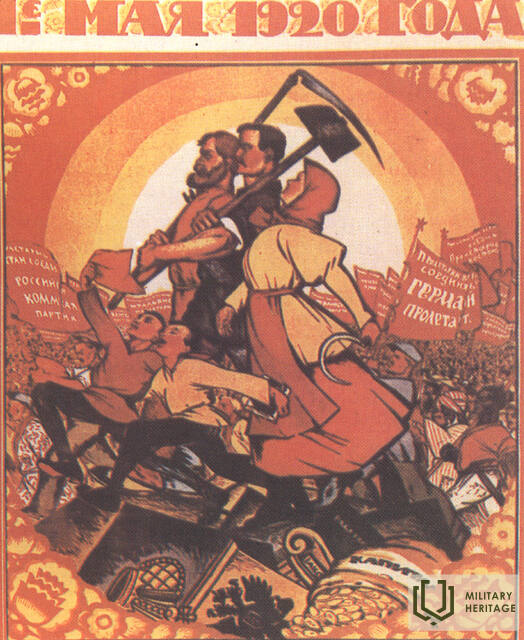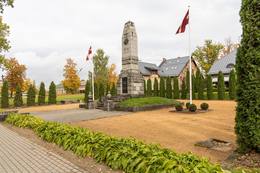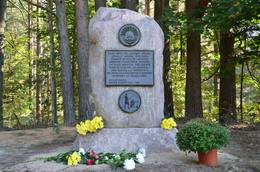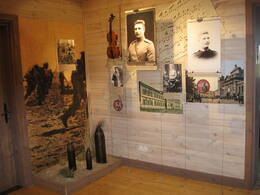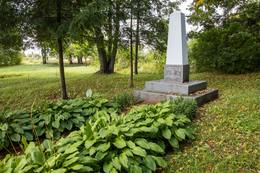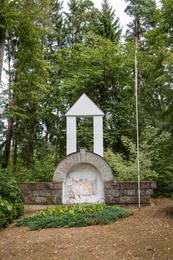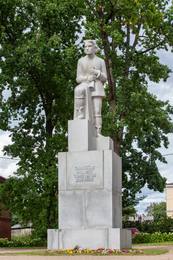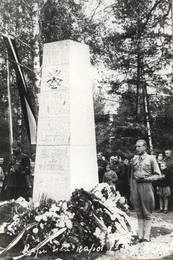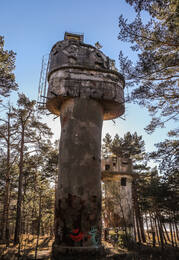Soviet Republic of Latvia, 1919-1920
I Wars of Independence
Socialist Soviet Republic of Latvia - Soviet regime in Latvia. Soviet Latvia was partly sovereign until 01.06.1919, after which it was actually part of Soviet Russia
Related timeline
Related objects
Monument to the fallen heroes of Gulbene parish for the freedom of Latvia
Located in the historical center of Gulbene, opposite the Gulbene Evangelical Lutheran Church.
Monument to the victims of the 1905 riots, the members of the Gulbene congregation who fell in World War I and the Latvian War of Independence, and the victims of the Maliena Tribunal. The monument was designed by E. Ābeltīns and was unveiled in 1929 opposite the Gulbene Evangelical Lutheran Church. After World War II, a five-pointed star was placed on the monument, then - on its base - a plaster image of a Soviet soldier painted in bronze, and a cemetery for fallen Soviet soldiers was established behind the monument. When in 1969 the new cemetery for Soviet soldiers who fell in World War II was opened in Spārīte Park, the remains of the fallen were transferred there, but the site of the monument was leveled with the ground. In the autumn of 1989, the foundations of the monument were excavated and the capsule with the text, which had been walled in them in 1928, was brought out. The monument was restored in 1992 (sculptor O. Feldbergs).
Between December 24, 1918 and May 31, 1919, when the 1st (4th) Valmiera Infantry Regiment liberated Gulbene from the Bolsheviks, the church housed the Maliena (Vecgulbene) Revolutionary Military Tribunal and Workers' Club. Its activities were notable for the severity of its decisions and the large number of death sentences, often for minor offenses - 349 cases were investigated, in which 606 persons were accused.
A memorial sculpture is visible.
A place of remembrance of the events of the Latvian War of Independence in Mārupe
Located in Mārupe municipality, on the side of the road between the golf club “Viesturi” and the Boži reservoir.
The memorial was unveiled in 2013. The history of the area is connected to the battle of the Latvian Army against Bermont's troops in 1919. Near the Adienņi house, Latvian Army units were deployed in battle positions.
During the War of Independence, due to the difficult situation, the Latvian government lacked the opportunity to supply the army with what was needed. The appearance and armament of the soldiers varied. Most often, the supply was based on the soldiers' ability to provide for themselves. At the end of September and the beginning of October 1919, a Latvian military order arrived from Great Britain to eliminate the shortages. A month later, a delivery of English armaments was also received. With the first cargoes, it was clear that Great Britain was getting rid of unnecessary supplies. Dirty, worn-out clothes and shoes were also received, which were often too small. When soldiers wore inappropriate shoes, health problems were created, which affected their combat capabilities. Clothing was repaired and sewn. The main unifying symbol was the 11-ray sun sign on the cap and a red-and-white bandage around the left arm.
Today, several memorial sites can be visited here. The sites are part of a scenic, specially designed historical and nature hiking route.
Guide Mikķelis Jakunovs, +371 28353679.
Oskars Kalpaks Museum and Memorial Site “Airītes”
The Oskars Kalpaks Museum and Memorial Site Airītes is located between Saldus and Skrunda near the A9 highway. The exhibit has extensive information about Colonel Oskars Kalpaks and his battalion, and shows the history of the Latvian National Army and the memorial site Airītes. The exhibit reveals Colonel Oskars Kalpaks as a personality, as a soldier and as a fighter for Latvia's independence. Audio logs in Latvian, English and German are also available as part of the exhibit. They emphasize the importance of the historic events of 1918/1919 in the protecting the statehood of Latvia. The museum building has been restored.
Entry is free; guided tour – for a fee. The complex has a recreation area, a park, an obstacle course, it is possible to take various classes, and there is a seminar hall for up to 30 people.
Monument to the soldiers of the 1st Liepāja Infantry Regiment at the site of the 1919 battles
Located in the village of Meža Strodi, Murmastiene parish, Madona region, 6km from Varakļāni.
The Freedom Struggle Monument can be seen at the site of the battle of the 1st Liepāja Infantry Regiment, where they fought against the “red” army in 1919. Not far from this place, a local resident Aleksandrs Lakstīgala was seriously wounded in battle. He was found dead near a nearby house. That is why the location of this monument was chosen.
On August 16, 1936, a granite Victory Monument (as it was called in the press of the time) was unveiled in memory of the Freedom Struggles, on which the words were engraved: "The place of the battles, sacrifices and victories of the 1st Liepāja Infantry Regiment in Latgale, on August 26, 1919, we bought every corner of our native land with our blood - it is now ours." It was erected by the leadership of the Rēzekne Guards Regiment, consecrated by the senior priest of the Rēzekne Guards Regiment, Vincents Tomašūnas, with the local parish priest Kalinkas. The opening parade was hosted by the commander of the Zemgale Division, Cavalier of the Lāčplēsis Order, Žanis Bachs. In 1950, it was demolished and destroyed. On November 16, 1996, the restored monument was solemnly unveiled, also in honor of the 78th anniversary of the proclamation of the Republic of Latvia.
Monument “Tālavas taurētājs”
Located in Rūjiena Center Square.
The three-meter-high image of an ancient Latvian guard soldier, carved from gray Finnish granite, called the “Tālavas trumpeter”, is placed on a three-meter-high granite pedestal, but the total height of the monument reaches 7.5 meters. In the initial sketches and models, K. Zemdega had placed a sword in the warrior’s hands, which was later replaced with a trumpet. The monument was unveiled on August 15, 1937.
This monument reflects the difficult situation in the formation of our state and army, as well as the assessment of these events. Immediately after the proclamation of the Latvian state, the Red Army invasion began and the provisional government of Kārlis Ulmanis found refuge in Liepāja. In February 1919, with the help of the Estonian army, the liberation of Latvia from the north began and the first mobilizations of the Latvian troops being formed in Tērbatas took place in the Rūjiena area, which, under the command of Colonel Jorģis Zemitāns, became the North Latvian Brigade. The North Latvian Brigade fought not only against the Bolsheviks, but also against the Landeswehr and the Iron Division in the battles of Cēsis. The North Latvian soldiers mobilized in the Rūjiena area also fought in subsequent battles of the War of Independence. After the war, the main laurels of victory went to General Jānis Balodis and the South Latvian Brigade commanded by him, but the North Latvian Brigade was often forgotten. The planned monument to the North Latvian Brigade in Rūjiena also took a long time to be created, and the monument, unveiled in 1937, was officially promoted as a monument to the liberation of the Rūjiena region and in memory of the fallen soldiers, without mentioning that all the regiments that were part of the North Latvian Brigade had their beginnings in Rūjiena.
The monument is not only a popular tourist attraction for Latvian and Estonian tourists, which is to some extent a starting point for visiting several other War of Independence memorial sites in Rūjiena, but the "Tālavas tauretājs" is also a stopping point for visits by Estonian and Latvian state and local government officials of various levels.
The Rūjiena Liberation and Fallen Soldiers Monument, more commonly known as the "Tālavas tauretājs" (Far-away Horner), was included in the list of state-protected cultural monuments on October 29, 1998 as an art monument of national importance (monument protection registration number 4522).
Karosta, the Military port of Liepāja (tour)
The Karosta is the largest historical military territory in the Baltics and occupies almost one third of the entire territory of Liepāja. The Karosta is a unique compound of military and fortification buildings on the shores of the Baltic Sea with a special meaning in the history and architecture of Latvia and the world. The Karosta features such military heritage sites as the North Pier and forts, the Redan, Karosta Prison, Karosta Water Tower, St. Nicholas Orthodox Maritime Cathedral, Oskars Kalpaks Bridge and others.
Related stories
The Battle of Cēsis on the banks of the Amata River
At the bridge over the Amata, the German Landeswehr attacks an Estonian armored train that has arrived for negotiations. The Estonians open counterfire, the Germans are repulsed, and the armored train returns to Cēsis.
The beginning, course and conclusion of the Battle of Cēsis
The victory in the Battle of Cēsis was destined to become a turning point in the Latvian and Estonian struggle for the independence of their country. This victory put an end to the plans of the Andrievs Niedra government and the German general Rüdiger von der Goltz to conquer the Baltics. Instead, the Latvian Provisional Government of Kārlis Ulmanis resumed its activities in Liepāja.
Colonel Kalpak's last battle near Airīte
Colonel Kalpaks was a respected figure in military circles and a true patriot. It was the spirit of patriotism and an unfortunate coincidence that led to the fatal clash between him and the German battalions, which unfortunately ended with the death of Colonel Kalpaks.
The Estonian Navy assists Latvian forces during the War of Independence
On June 23, Estonians celebrate Victory Day, thus marking the joint Latvian-Estonian victory in the Battle of Cēsis. And in this victory, the Estonian Navy played a significant role, which in this Landeswehr war, as the Estonians call it, with its courageous actions and accurate cannon fire at the mouth of the Daugava threatened the main supply routes of the German forces across the Daugava in the immediate vicinity of Riga.
About the first Commander-in-Chief of the Latvian Army, Dāvids Sīmansons
The essays in the book "Commanders of the Latvian Army" convince us that history is significantly influenced by specific individuals. Although they were at the epicenter of the most important historical events for a short time, true Latvian patriots, with their rich military experience, managed to do a lot in the formation and strengthening of the Latvian army and in the turning points of historical events.
This story is about the first Commander-in-Chief of the Latvian Army, Dāvids Sīmansons (1859-1933).
Cape and the ship "Saratov"
It can be assumed that Liepaja was the capital of Latvia for a short period of time, because during the Freedom Struggle the Provisional Government was stationed on the ship Saratov in this very city. The Saratov took the Provisional Government to Riga after its liberation, but many people do not know that the history of such an important ship for us ended at sea at Akmenrags.




